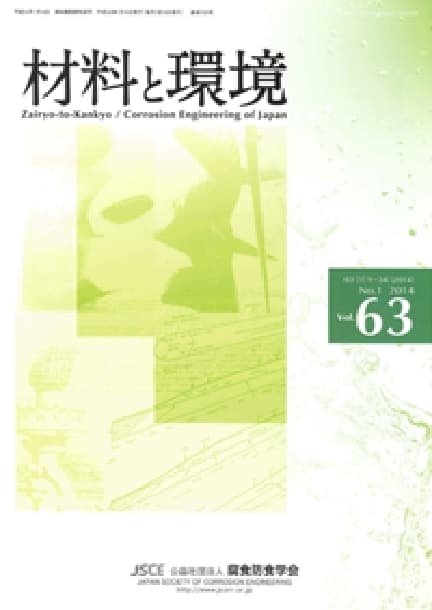材料と環境 Vol. 62 (2013), No. 7
Backnumber
-
Vol. 74 (2025)
-
Vol. 73 (2024)
-
Vol. 72 (2023)
-
Vol. 71 (2022)
-
Vol. 70 (2021)
-
Vol. 69 (2020)
-
Vol. 68 (2019)
-
Vol. 67 (2018)
-
Vol. 66 (2017)
-
Vol. 65 (2016)
-
Vol. 64 (2015)
-
Vol. 63 (2014)
-
Vol. 62 (2013)
-
Vol. 61 (2012)
-
Vol. 60 (2011)
-
Vol. 59 (2010)
-
Vol. 58 (2009)
-
Vol. 57 (2008)
-
Vol. 56 (2007)
-
Vol. 55 (2006)
-
Vol. 54 (2005)
-
Vol. 53 (2004)
-
Vol. 52 (2003)
-
Vol. 51 (2002)
-
Vol. 50 (2001)
-
Vol. 49 (2000)
-
Vol. 48 (1999)
-
Vol. 47 (1998)
-
Vol. 46 (1997)
-
Vol. 45 (1996)
-
Vol. 44 (1995)
-
Vol. 43 (1994)
-
Vol. 42 (1993)
-
Vol. 41 (1992)
-
Vol. 40 (1991)
キーワードランキング
22 Dec. (Last 30 Days)
材料と環境 Vol. 62 (2013), No. 7
Fe-Cr合金の腐食反応における活性化エネルギーの組成依存性について
長澤 慎, 松橋 亮, 木村 謙
pp. 254-258
DOI:
10.3323/jcorr.62.254抄録
Composition dependence of chemical activation energy was considered by separating apparent activation energy(ΔQa)of pure Fe, Cr and Fe-Cr alloys 1N-H2SO4 solution into two factors, chemical and electric one.
Corrosion reaction of Fe-Cr alloys was found to be determined by anodic dissolution of metals and cathodic reaction of H+ reduction had less effect on the reaction. Thus, relationship between chemical activation energy and Cr content was investigated in terms of metal dissolution. We assume that the standard electrode potential of Fe-Cr alloy decreased linearly with increasing Cr content based on the fact that the standard electrode potential of pure Fe is more noble than that of pure Cr and also on the results indicating that corrosion potential of Fe-Cr alloys decreased linearly with Cr content. From the assumption, chemical activation energy(Q0)was estimated by subtracting electric factor from ΔQa. It was found that Q0 decreased lineally by the increase of Cr content in the range of no more than 40% Cr, but it increased with Cr content in the range higher that 40% Cr.
We estimated chemical activation energy of Fe and Cr(partially mole activation energy)in Fe-Cr alloys for obtained Q0 by applying the concept of the additive of thermodynamic partial molar quantity. And it was revealed that Q0 of Cr was remarkably decreased in Fe-Cr alloys compared with one in pure Cr. It was considered that increase of corrosion rate with Cr content of Fe-Cr alloys was attributable to decrease of Q0 of Cr in pure Cr comparing to one of Cr in Fe-Cr alloys.
304ステンレス鋼板の表面および断面の孔食発生挙動に及ぼすS含有量の影響
斎田 知明, 中井 創平, 佐藤 克明, 黒田 健介, 興戸 正純
pp. 259-266
DOI:
10.3323/jcorr.62.259抄録
In order to clarify the influence of sulfur content on the pitting corrosion behavior of surface, L-section (longitudinal section)and T-section(transverse section)of stainless steel plate, cyclic corrosion test(CCT)and anodic polarization measurement in 0.85 M NaCl aqueous solution have conducted. Thick plate specimens (t 25 mm)of type 304 stainless steels containing 7, 29 and 57 ppm S were subjected to these tests. In CCT, rusting was more significant over T-section than surface and L-section. However, the number of initial rust spots over the T-section decreased with a reduction of S content. In pH 7 solution, the pitting potential(Epit)for 57 ppm S specimen was less noble at T-section than surface and L-section. But Epit at the T-section was shifted toward noble side with a reduction of S content. On the other hand, in pH 1 solution, Epit was low value regardless of S content. Furthermore, the cross-sectional shape of pits originated from MnS inclusion at the T-section was investigated. The MnS inclusion stretched into the steel matrix along the rolling direction and the growth of pitting corrosion along the MnS inclusion were observed.
他の人はこちらも検索
ISIJ International Vol.53(2013), No.10
鉄と鋼 Vol.98(2012), No.7
鉄と鋼 Vol.100(2014), No.12
論文アクセスランキング
22 Dec. (Last 30 Days)
-
大気腐食環境下における1700 MPa級調質ボルトの遅れ破壊機構
鉄と鋼 早期公開
-
Perspectives on the Promising Pathways to Zero Carbon Emissions in the Steel Industry toward 2050
ISIJ International Vol.65(2025), No.2
-
-
Factors Influencing the Bonding Phase Structure of Iron Ore Sinters
ISIJ International Vol.43(2003), No.9
-
-
-
Metallurgical Aspects on Interstitial Free Sheet Steel From Industrial Viewpoints
ISIJ International Vol.34(1994), No.1
-
冷間ねじり加工した純鉄におけるフェライトの異常粒成長挙動
鉄と鋼 早期公開
-
Influence of Antimony on the Oxidation Characteristics of 65Mn Steel
ISIJ International 早期公開
-
この機能はログイン後に利用できます。
下のボタンをクリックしてください。










